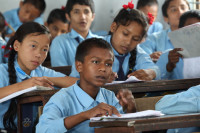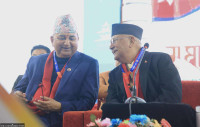Opinion
Poor people’s problem
An antivenom shortage has led to preventable deaths from snakebites in rural Nepal
Deb P Pandey
Snakebite is the most neglected medical emergency particularly in the southern lowlands of Nepal. A large number of envenomed victims can survive only if they are treated with antivenom serum as quickly as possible. If such treatment centres are located far away, appropriate first aid measures can delay dissemination of the venom in the victim´s body until a treatment with antivenom. Because the problem is confined to poor people without political clout, no effective programmes have been implemented to address frequent antivenom shortages. Producing quality antivenom in Nepal, like in other underdeveloped countries, is an expensive project. However, if plans are made to produce antivenom using Nepali human resources to support international experts, and humanitarian aid is used as seed money, it is not far away.
Antivenom was first developed by French scientist Albert Calmette in 1895. To produce antivenom, the venom from a single or many snakes is administered to a horse. The horse gradually develops immunity (antibodies) against this venom. The antibodies are special proteins which are developed in the blood of the experimental animals. They are extracted and refined. These special and refined proteins are called antivenom. In this way, medicine for the treatment of snakebite is prepared. The government of Nepal, World Health Organisation (WHO) or other humanitarian organisations should work to make this medicine cheaply and easily available. This life-saving drug should be distributed to all qualified health institutions in regions where snakebite is common. Probably due to the effect of climate change, snakebite cases are increasing in the hills of Nepal. Therefore, the shortage of antivenom should be addressed soon.
We frequently face serious consequences due to the scarcity of antivenom across the country. This is because antivenom is not a priority emergency medicine for the Nepal government which has been incapacitated by political instability and infectious diseases like bird flu, diarrhoea and malaria. This situation has also been attributed to policymakers who act as if they are tired after managing other public health issues and are less concerned about snakebite problems. However, this is one of the genuine and severe health problems for all the rural people in Nepal, no matter which political party or ideology they favour.
Nepal needs about 40,000 vials of antivenom annually. Each vial costs Rs1,051. The government spends about Rs42 million annually to buy antivenom from producers in India. If we can produce this medicine in Nepal, we will not only eliminate antivenom shortages but also strengthen the national economy by preventing money from going out of the country. To produce effective antivenom in Nepal, some basic research needs to be done. This is because the efficacy of Indian polyvalent antivenom is a question mark. There is no scientific information to comment on the efficacy of Indian antivenom for snakebite management in Nepal. Recently accomplished clinical studies of snakebites may disclose the effectiveness of Indian antivenom against the venoms of snakes in Nepal. However, it will take about five years to get rid of this problem even if the government, non-governmental organisations or private companies start work today to produce antivenom in Nepal.
Therefore, the antivenom required by Nepal should be initially produced in other countries having the necessary technology and production capacity using the venom of Nepali snakes. However, for a long-term solution to the problem, regular production of antivenom in Nepal using its own resources would be desirable. Because antivenom is expensive and the consumers are poor people, it is not a profitable business. Therefore the government of Nepal should seek support from WHO and other humanitarian organisations to ensure its regular production and supply in or outside the country.
As an immediate step, the government should involve a producer who can supply the best quality, safe and cost-effective antivenom and sign a long-term contract for the supply of Nepali snake venom to the selected producer. Despite revolutionary achievements in medicine, lack of political will or awareness, economic crisis, low interest level of the public health sector and lack of coordination among scientists, human resources and technology, politicians and policymakers have failed to make life-saving antivenom available to the people when they need it. In order to ensure public access to antivenom within half an hour to one hour of being bitten by a snake, these key persons should play a vital role in this regard.
Despite the challenges and the high outlay involved, the government should motivate Nepali investors and empower Nepali human resources besides creating antivenom production policies. Until a conducive environment is prepared and an organised and qualified taskforce is ready to produce antivenom in Nepal, the government should negotiate with Indian antivenom companies and the Indian government to continue its supply to Nepal. It can also request producers in Thailand and other countries to supply their products to Nepal.
Pandey holds a PhD from Goethe University, Germany




 16.12°C Kathmandu
16.12°C Kathmandu










